Imagine if you can keep your porcelain sink clean, fresh, and shiny as ever with minimum effort. Or better, what if there are just simple, homemade ways to get rid of any stains from the porcelain sink of your kitchen or bathroom?
Now, who wouldn’t want to know these easy and handy ways? Let’s discover the best and easy ways of cleaning porcelain sink and keeping it sparkly as ever.
Cleaning Schedule | General Cleaning Methods | Intense Cleaning | Maintenance
Porcelain sinks
Sinks made of porcelain beautifully complement any style of home. Porcelain surface, however, needs a little more and often cleaning and stain removal, unlike regular sinks.
After fitting a porcelain sink, first off, you need to know how to clean the porcelain sink.
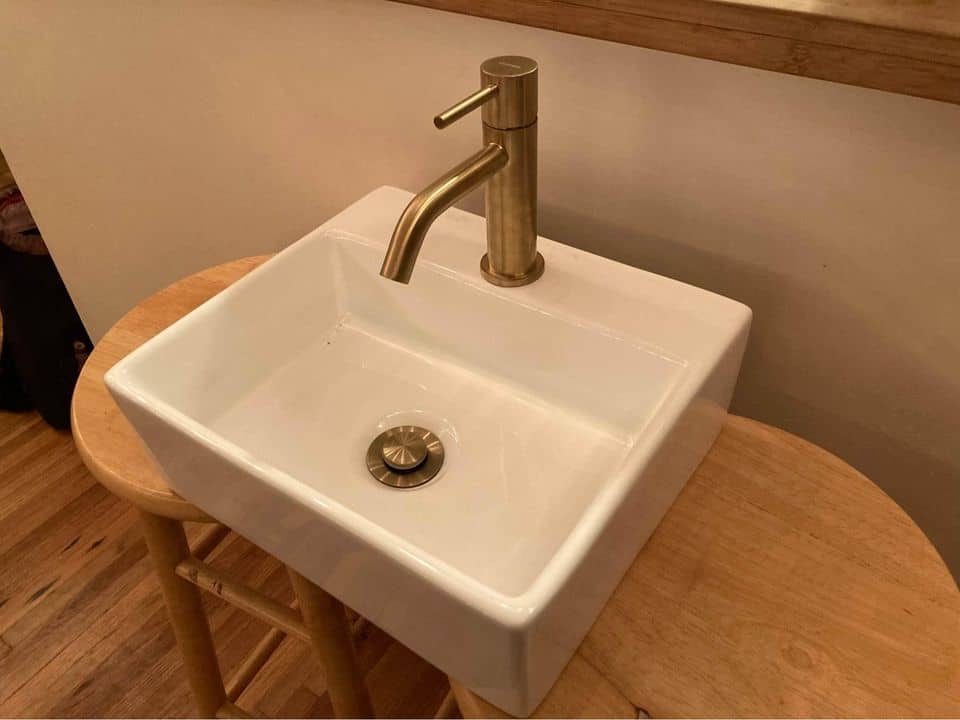
Why Does It Need Care?
Nevertheless, porcelain is prone to holding onto stains and is easily scratched if rubbed with abrasives to remove stains. The good news is that porcelain does not permanently stain unless it is extensively worn or scratched. Your porcelain sink can remain sparkling for years with proper care.
Simply put, porcelain consists of raw materials: kaolin, feldspar, quartz, and clay. These raw materials contribute to the high resistance and luminosity of porcelain.
Additionally, porcelain is a non-porous substance and hygienic. With its delicate beauty, porcelain is elegant, timeless, and suited for any occasion. Hence, porcelain sinks, in particular, require special care.
How Often Should You Clean It?
First, let’s understand how often you should clean your porcelain sink. Porcelain sinks require routine maintenance.
Ideally, one should clean the porcelain sink weekly with a gentle cleanser and mild abrasive to prevent the accumulation of oil, dirt, and soapy residue. At least once a month, you should perform a deep cleaning of your porcelain sinks.
Different Ways to Clean
Before trying the cleaning methods, preferably try to use mild dishwashing detergent, hot water, and a damp cloth to clean your porcelain sink.
Now that the grease, accumulated food, and any minor stains are gone, you’re all set to try the methods mentioned below.
Listed here are a few of the best methods you should try to clean your porcelain sink and` keep it sparklier than ever.
Black Porcelain Sink
Black porcelain sink gives an elegant and premium touch to your kitchen or bathroom. Sinks are also scratch-resistant since made of a combination of granite, quartz, slate, and other materials.
However, black sinks are susceptible to white stains and films. Stated below are a few of the best cleaning hacks to get rid of these stains.
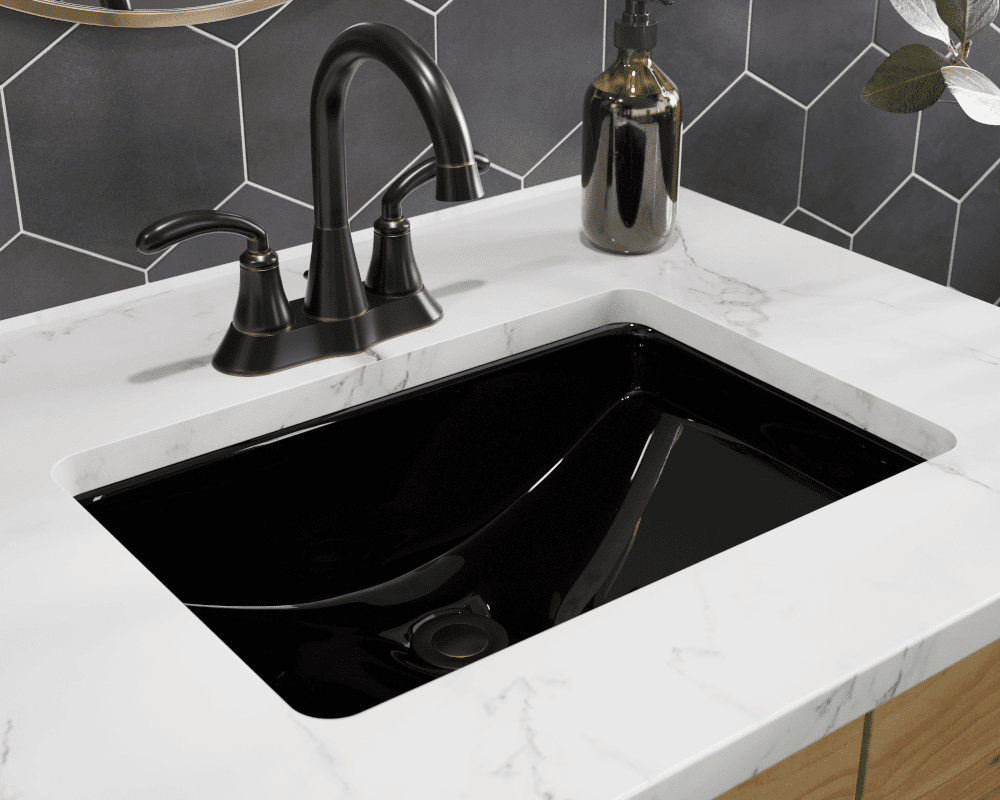
Dishwashing Detergent
For mild stains, such as oil, dirt, or food buildup:
You only need liquid dish soap and a soft sponge. At first, rinse the black sink thoroughly with water. Then, take the dishwashing detergent on the sponge and start scrubbing the stains in a circular motion and rinse again when done.
Baking Soda
For coffee, tea, or wine spilled stains:
Sprinkle baking soda on the stains thoroughly. Let it rest for about 30 minutes till the stains get uplifted. Next, using a wet cloth, clean the sink thoroughly and rinse with clean water.
Ammonia
A black porcelain sink is likely to develop a white film caused by soap residue. To get rid of this white film and restore the black shine of your sink, clean your sink with ammonia.
To start with,
- Add a tablespoon of ammonia to 1 liter of hot water and rinse your sink with this mixture.
- Remember to clean your sink with clean water to wash the ammonia thoroughly.
You will see that the white film has disappeared while returning the shine on your black porcelain sink.
Caution: Always use gloves while cleaning with ammonia because If ammonia touches your skin, it might irritate your skin. Make sure the room has ventilation while using ammonia to clean your sink.
Colored/ White Porcelain Sink
Extensive scrubbing or use of high abrasive agents can damage the white porcelain kitchen sink/bathroom sink.
Therefore, while cleaning colored/ white porcelain sinks of your kitchen or bathroom, use light abrasive agents such as Bar Keepers Friend to sustain the shine and life of your sinks. Make sure to use it moderately.
Remember: Bleach helps in removing the stains from white porcelain ONLY.
Do not use chlorine bleach to clean colored porcelain.
The best alternative for white/colored porcelain sinks is liquid oxygen bleach, particularly, hydrogen peroxide because it is less corrosive.
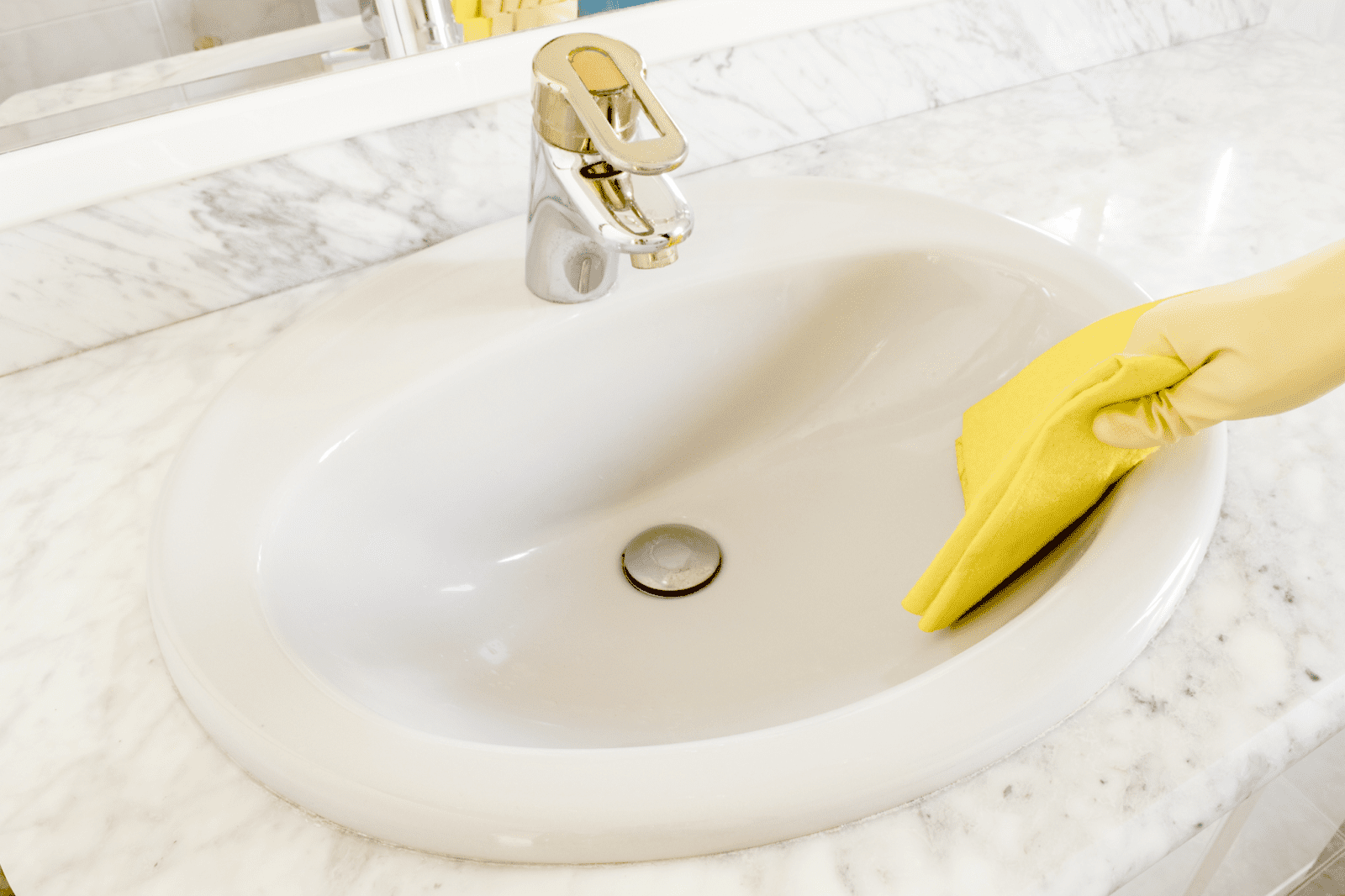
Oxygen Bleach – Hydrogen Peroxide
You need to:
- First, wear gloves while using hydrogen peroxide to clean your sink.
- Place a layer of paper towels covering the sink.
- Fill a spray bottle with hydrogen peroxide and spray the hydrogen peroxide onto these paper towels until soaked completely.
- Let the bleach sit for at least 30 minutes to 1 hour.
- Remove the bleached paper towels and thoroughly rinse the sink with clean water.
Tip: White vinegar is a better alternative solution if you are concerned about bleach on an antique porcelain sink.
Cleaning Methods for Different Problems
Other than the regular stains, some special stains require different cleaning products or cleaning solutions. Listed here are different types of stubborn stains and their best possible solutions.
Hard Water Stains
Calcium, lime, and mineral deposits develop on the surface of porcelain over time, causing hard water stains. Washing with water or soap alone will not always work.
The remedies suggested below might be helpful to eliminate the hard water stains.
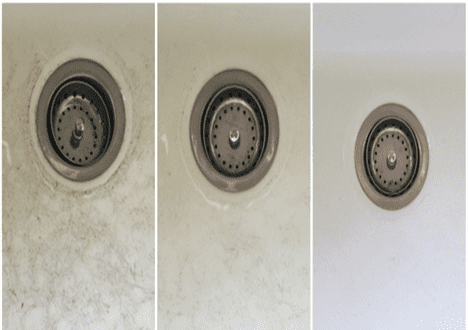
White Vinegar
Although vinegar can clean and sanitize your entire sink, it works particularly well on hard water stains and soap residue.
- Firstly, rinse the sink with clean water.
- After rinsing, fill the sink with hot water and stop the drain.
- Now, add ½ cup of white vinegar to the hot water and let this mixture sit for about 3-4 hours.
- After 3 hours, drain the hot water and vinegar and clean the sink with a soft cloth.
Along with hard water stains, white vinegar helps clean dirty yellow stains from your porcelain sinks.
Lime A-way
Lime A-way is a porcelain cleaner formulated to remove hard water stains and lime deposits from your sinks or bathtubs.
Follow the directions given on the product carefully. Make sure you wear gloves and goggles while using an acid-based cleaner.
Note: Ensure you use Lime A-way occasionally because it can eventually erode the porcelain finish.
Rusty Stains
Porcelain sinks, in particular, may develop rust stains that are difficult to remove with the daily cleaning methods. Hence, you might need to use the table salt and lemon method or rust removers to clean your porcelain sinks.
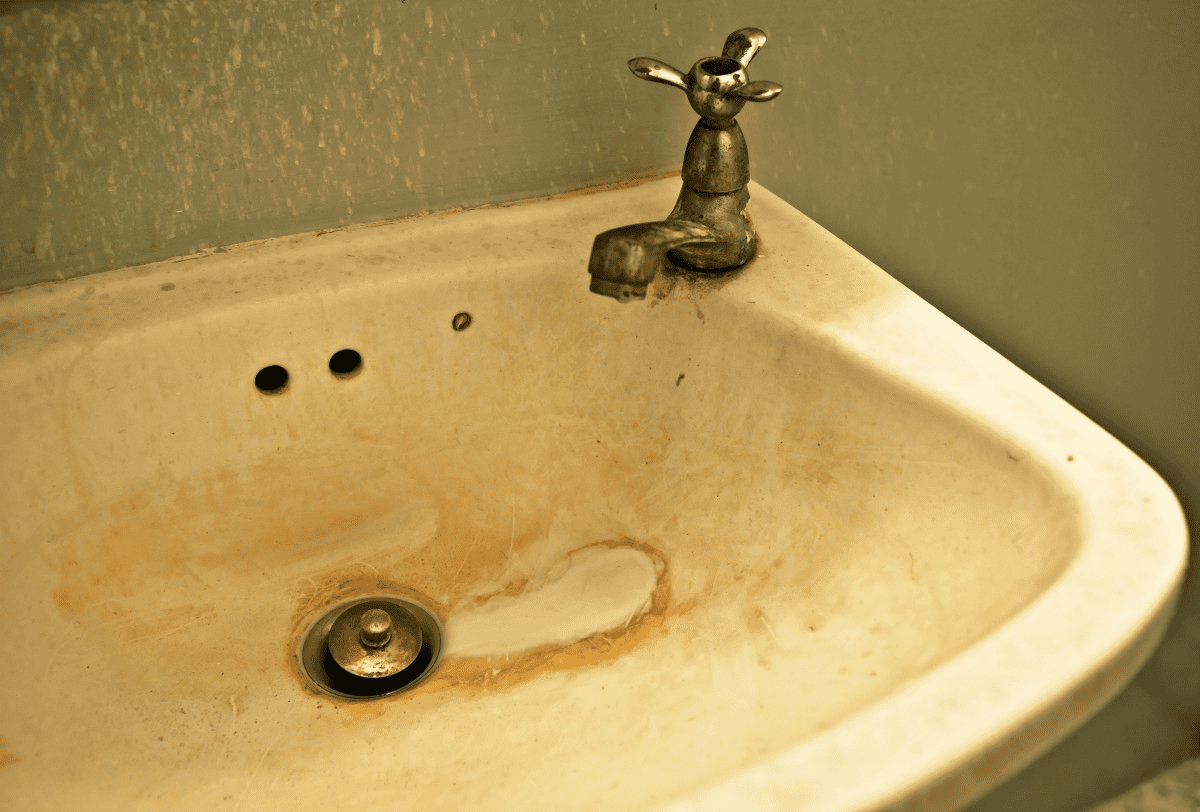
Lemon Juice and Salt
In this method, you have to
- Evenly sprinkle table salt on the affected areas of the sink until fully covered.
- Now, slice the lemon in halves and squeeze the lemon juice over the salt.
- Soft scrub the stain with the help of either a soft cloth or nylon sponge.
- If you can still see the rust stain, let the salt and lemon juice sit there for an hour before scrubbing again.
- Finally, rinse the sink with clean water and wipe the sink with a soft clean cloth.
Tip: You can even apply some lemon oil onto the porcelain sink to make it shiny. The oil will act as an additional layer of protection to the porcelain sink.
Rust Remover
You can always turn to rust removers. They help in eliminating stubborn rust stains. Make sure to use the remover as suggested on the product. Follow the given instructions carefully to have a clean and shining sink in your kitchen or bathroom.
You can use Naval Jelly for rust stains. However, you should use it cautiously as it is used to remove rust from metals. It would help if you rinsed immediately when you see any changes in the rust stain after application.
Scratched Sink
Although porcelain sinks are sturdy, long-lasting materials, unpleasant scratches are simple to spot.
If you see your porcelain sink scratched or any scuff marks, you don’t have to throw it away or hire a professional to fix it; there are several DIY ways to remove scratches from your porcelain sink.
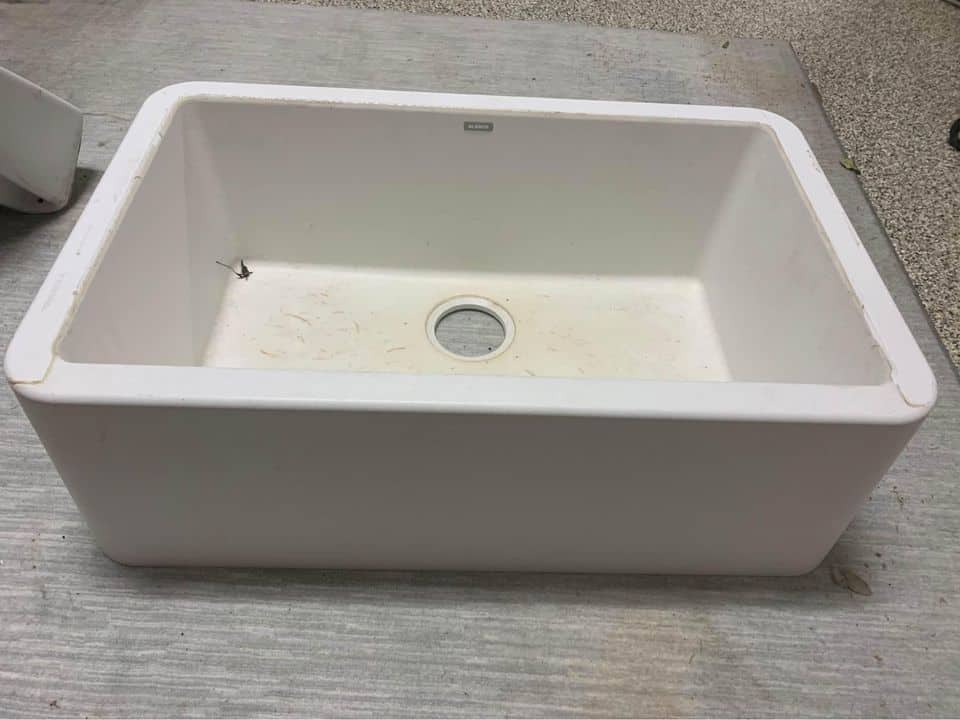
Baking Soda
Baking soda helps in eliminating mild porcelain sink scratches.
- Start with simply sprinkling baking soda over the scratch, or cover the entire sick with it.
- The next step, use a wet cloth to wipe out the scratches.
- Make sure to rub the baking soda in a back and forth on the scratch.
- Rub baking soda in your sink for a few minutes, then rinse it with warm water.
Consider using Bar Keeper’s Friend if the scratches remain.
Smelly Sink
Food particles, grease, and other things end up in the sink drain, and the sink smells foul the next day. Baking soda and vinegar are the two powerful ingredients for cleaning smelly porcelain sinks.
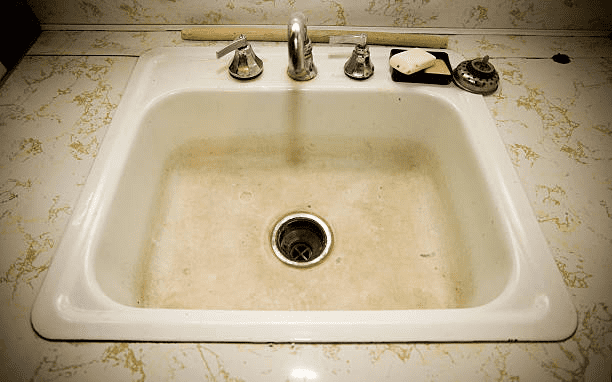
Baking Soda with Vinegar
- Drizzle a couple of tablespoons of baking soda in the drains and pour one cup of vinegar after baking soda down the drains.
- It is natural for it to bubble up. Allow this to sit for about 30 minutes before running water down the drains.
The baking soda and vinegar will neutralize the odor without using water.
This method helps unclog the drains as well. It does wonder in cleaning the porcelain sink and removing the foul smell.
If there are some grease or stains left, apply a decent amount of Elbow Grease to the affected area. After 15 minutes, wash the sink with warm water. And you are all set!
Tips for A Shiny Porcelain Sink
Now that your porcelain sink is cleaned and fresh with the methods as per the stains, it is time to refinish your sink and make it sparklier than ever.
Here is a list of things you can use to preserve the shine and polish of your porcelain sink at home.
- Re-glazing kit
- Lemon oil/baby oil
- Car wax
As the methods and cleaning tips mentioned above are simple, you can try these to clean your porcelain sink and keep them shining. Happy cleaning!
Check out this video for before and after the result:
![Granite Vs. Marble Vs. Quartz Countertops [12 Differences+Pros & Cons] Granite Vs. Marble Vs. Quartz Countertops [12 Differences+Pros & Cons]](https://houseadorable.com/wp-content/uploads/2022/03/quartz-marble.jpg)



![What Are Kitchen Sinks Made Of ? [13 Types+Pros & Cons] What Are Kitchen Sinks Made Of ? [13 Types+Pros & Cons]](https://houseadorable.com/wp-content/uploads/2022/01/Sink-MAterial.jpg)
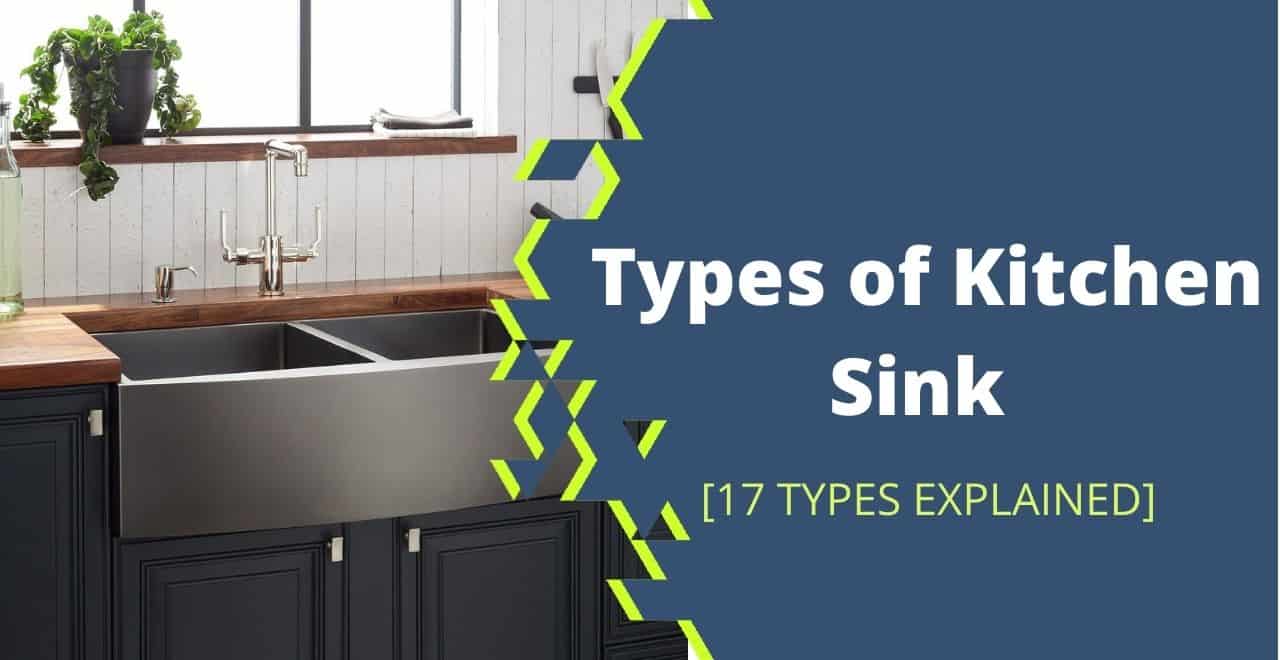
![Ceramic vs Stainless Steel Sink [A Detailed Analysis] Ceramic vs Stainless Steel Sink [A Detailed Analysis]](https://houseadorable.com/wp-content/uploads/2021/12/Ceramic-vs-ss.jpg)
![Chrome Vs. Stainless Steel Faucets: [An In-Depth Analysis] Chrome Vs. Stainless Steel Faucets: [An In-Depth Analysis]](https://houseadorable.com/wp-content/uploads/2023/03/51gDGcVWBL._AC_UF10001000_QL80_-250x250.jpg)